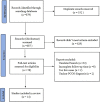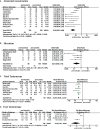Metabolic Surgery on Patients With Polycystic Ovary Syndrome: A Systematic Review and Meta-Analysis
- PMID: 35360056
- PMCID: PMC8961297
- DOI: 10.3389/fendo.2022.848947
Metabolic Surgery on Patients With Polycystic Ovary Syndrome: A Systematic Review and Meta-Analysis
Abstract
Polycystic ovary syndrome (PCOS) is a complicated reproductive endocrine disease that is closely related to obesity. Metabolic surgery ameliorates a series of clinical manifestations and related comorbidities of PCOS. However, the overall efficacy of metabolic surgery on PCOS remains uncertain. This systematic review and meta-analysis aimed to evaluate the therapeutic effects of metabolic surgery on obese patients with PCOS. A systematic literature search for relevant studies was conducted on PubMed, Embase, Web of Science, and the Cochrane Library from inception to June 2021. Data extraction and quality evaluation were performed by three researchers, and RevMan 5.4 software was used to conduct the meta-analysis. A total of 14 studies involving 501 obese patients with PCOS were included. Incidence of PCOS in obese women ranged from 5.5% to 63.5% among the included studies. The results showed the incidence of abnormal menstruation decreased from 81% to 15% (OR=0.03, 95% confidence interval (CI): 0.01-0.08), while the incidence of hirsutism dropped from 71% to 38% (OR=0.21, 95% CI: 0.06-0.74). Serum total testosterone and free testosterone levels decreased by 25.92 ng/dL (MD = -25.92, 95% CI: -28.90- -22.93) and 2.28 ng/dL (SMD = -2.28, 95% CI: -3.67- -0.89), respectively. Sex hormone-binding globulin (SHBG) levels increased by 26.46 nmol/L (MD = 26.46, 95% CI: 12.97-39.95). Serum anti-Mullerian hormone (AMH) levels decreased by 1.29 ng/mL (MD = -1.29, 95% CI: -1.92- -0.66). Small sample size studies revealed that pregnancy rates ranged from 95.2% to 100% postoperatively. Metabolic surgery contributed to marked improvement of abnormal menstruation, hirsutism, and levels of free testosterone, total testosterone, SHBG, and AMH in patients with PCOS. Our findings indicate that patients with PCOS are expected to benefit from metabolic surgery, and could help potentially improve their reproductive outcomes. Metabolic surgery could thus be a new viable option for the clinical treatment of PCOS.
Systematic review registration: PROSPERO https://www.crd.york.ac.uk/PROSPERO/, identifier CRD42021251524.
Keywords: bariatric surgery; meta-analysis; metabolic surgery; obesity; polycystic ovary syndrome; systematic review.
Copyright © 2022 Yue, Huang, Zhang, Li, Liu, Zhao, Shu, Liu, Li and Liu.
Conflict of interest statement
The authors declare that the research was conducted in the absence of any commercial or financial relationships that could be construed as a potential conflict of interest.
Figures




Similar articles
-
Effects of bariatric surgery on the menstruation- and reproductive-related hormones of women with obesity without polycystic ovary syndrome: a systematic review and meta-analysis.Surg Obes Relat Dis. 2022 Jan;18(1):148-160. doi: 10.1016/j.soard.2021.09.008. Epub 2021 Sep 10. Surg Obes Relat Dis. 2022. PMID: 34756568
-
Effects of bariatric surgery on obese polycystic ovary syndrome: a systematic review and meta-analysis.Surg Obes Relat Dis. 2019 Jun;15(6):942-950. doi: 10.1016/j.soard.2019.03.032. Epub 2019 Apr 3. Surg Obes Relat Dis. 2019. PMID: 31113751
-
Circulating kisspeptin and anti-müllerian hormone levels, and insulin resistance in women with polycystic ovary syndrome: A systematic review, meta-analysis, and meta-regression.Eur J Obstet Gynecol Reprod Biol. 2021 May;260:85-98. doi: 10.1016/j.ejogrb.2021.03.007. Epub 2021 Mar 11. Eur J Obstet Gynecol Reprod Biol. 2021. PMID: 33744505
-
Impact of Ketogenic Diet on Weight, Metabolic, and Endocrine Parameters in Women with Polycystic Ovary Syndrome: A Systematic Review and Meta-Analysis.Gynecol Obstet Invest. 2025 Feb 20:1-19. doi: 10.1159/000543941. Online ahead of print. Gynecol Obstet Invest. 2025. PMID: 39978319 Review.
-
Bariatric Surgery Reduces Serum Anti-mullerian Hormone Levels in Obese Women With and Without Polycystic Ovarian Syndrome.Obes Surg. 2017 Jul;27(7):1750-1754. doi: 10.1007/s11695-016-2528-y. Obes Surg. 2017. PMID: 28378209
Cited by
-
Towards precision medicine in bariatric surgery prescription.Rev Endocr Metab Disord. 2023 Oct;24(5):961-977. doi: 10.1007/s11154-023-09801-9. Epub 2023 May 2. Rev Endocr Metab Disord. 2023. PMID: 37129798 Free PMC article. Review.
-
The impact of obesity surgery on newborn anthropometrics in women with and without polycystic ovary syndrome.Arch Gynecol Obstet. 2024 Oct;310(4):2007-2014. doi: 10.1007/s00404-024-07593-0. Epub 2024 Jul 1. Arch Gynecol Obstet. 2024. PMID: 38951260 Free PMC article.
-
Total weight loss rather than preoperative body mass index correlates with remission of irregular menstruation after sleeve gastrectomy in patients with polycystic ovary syndrome.Front Endocrinol (Lausanne). 2024 Mar 11;15:1355703. doi: 10.3389/fendo.2024.1355703. eCollection 2024. Front Endocrinol (Lausanne). 2024. PMID: 38529391 Free PMC article.
-
Comparison of the effects of laparoscopic sleeve gastrectomy and endoscopic intragastric balloon placement on hormone profile and menstrual cycle in obese women with polycystic ovary syndrome.BMC Surg. 2025 Jul 16;25(1):297. doi: 10.1186/s12893-025-03039-9. BMC Surg. 2025. PMID: 40670974 Free PMC article.
-
Predictive Factors of Menstrual Recovery After Laparoscopic Sleeve Gastrectomy in Polycystic Ovary Syndrome Women with Obesity.Diabetes Metab Syndr Obes. 2023 Jun 13;16:1755-1766. doi: 10.2147/DMSO.S411573. eCollection 2023. Diabetes Metab Syndr Obes. 2023. PMID: 37334183 Free PMC article.
References
-
- Williams T, Mortada R, Porter S. Diagnosis and Treatment of Polycystic Ovary Syndrome. Am Family Physician (2016) 94(2):106–13. - PubMed
Publication types
MeSH terms
Substances
LinkOut - more resources
Full Text Sources
Medical
Miscellaneous

